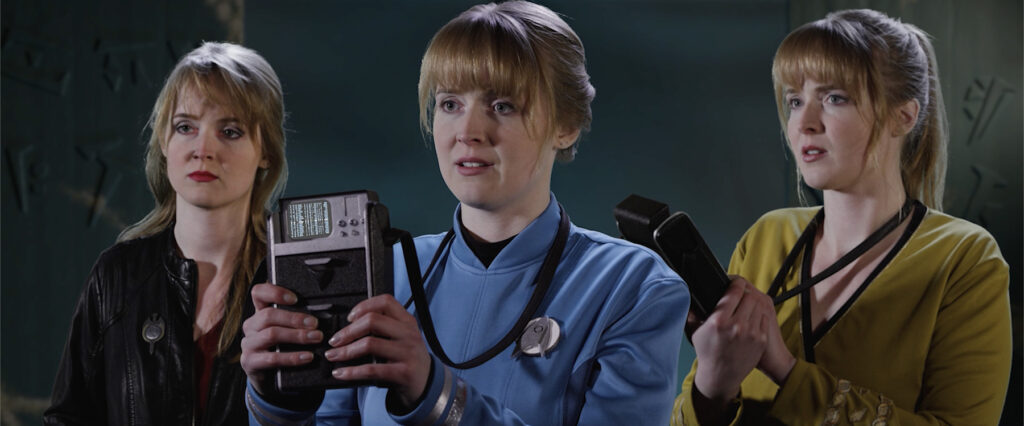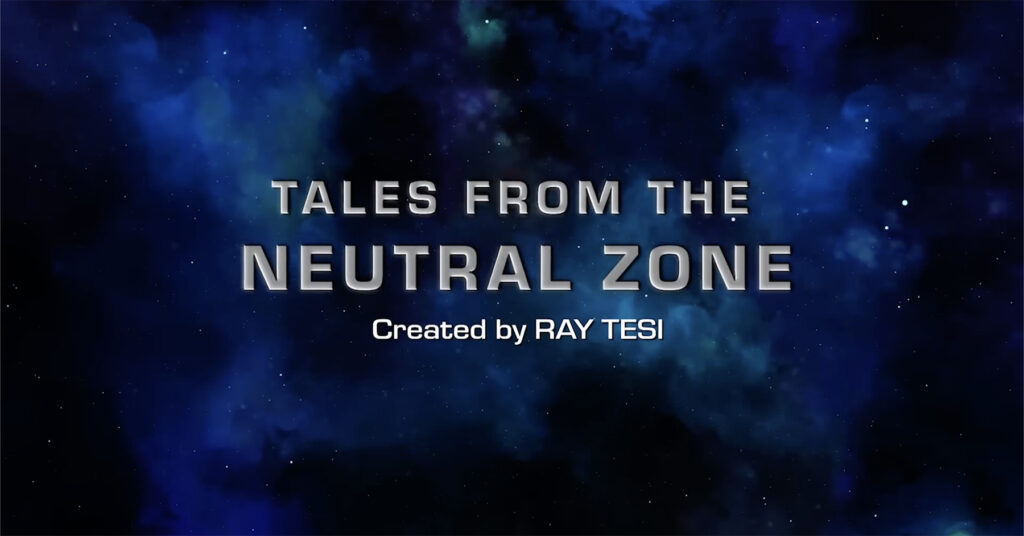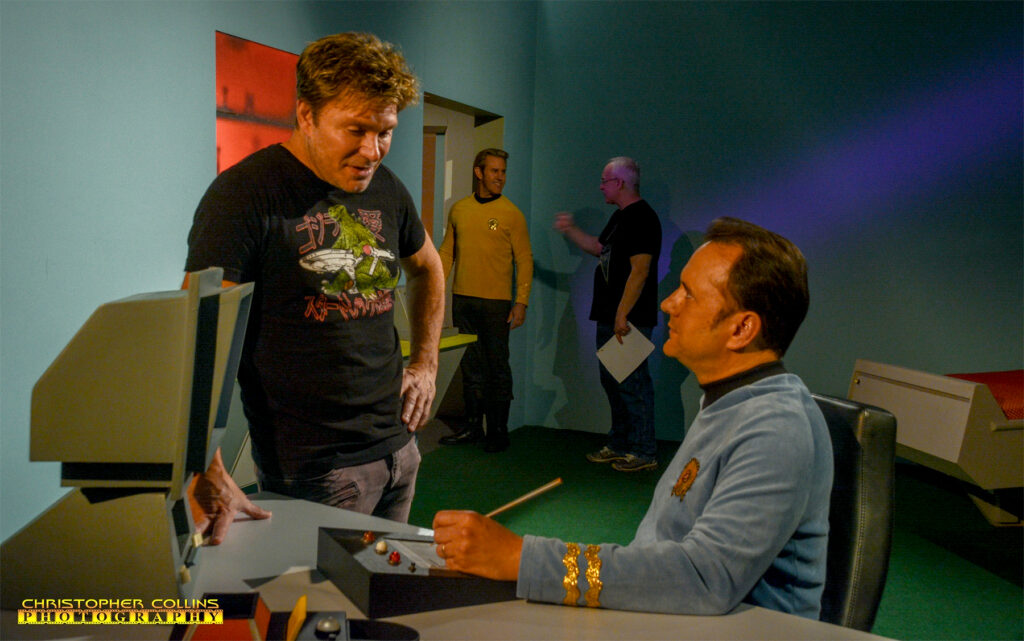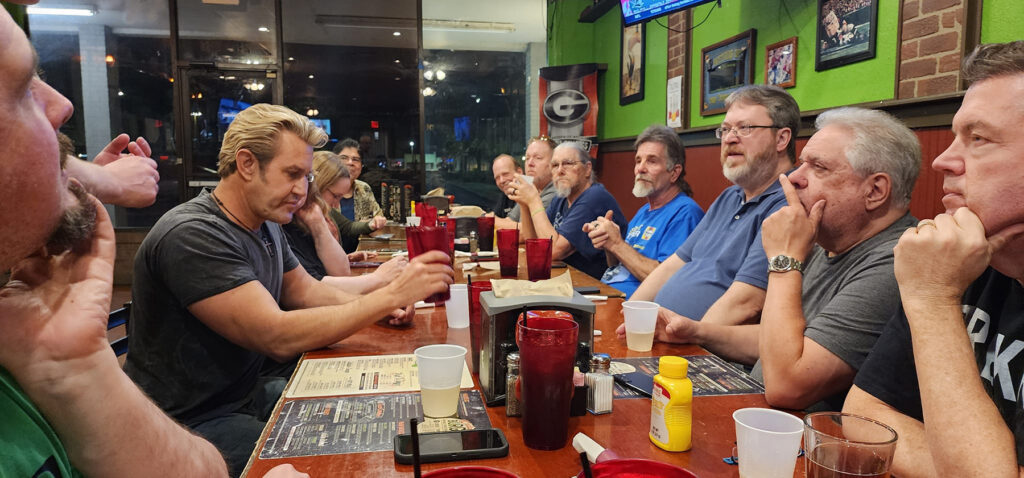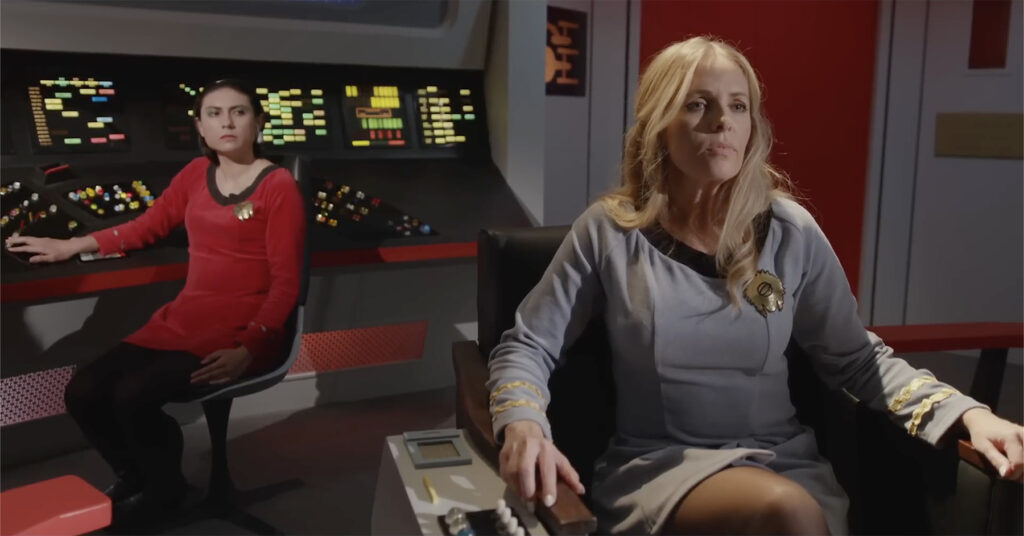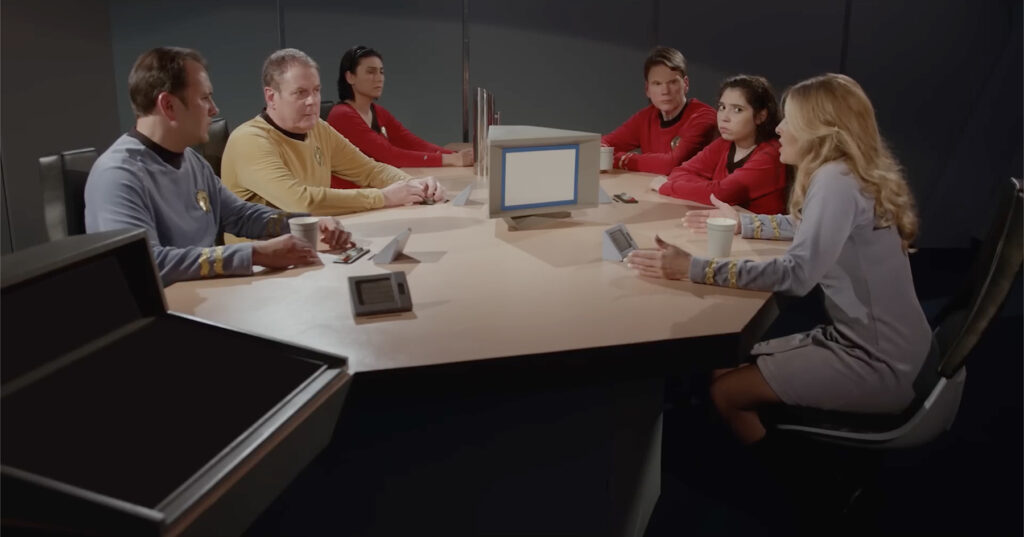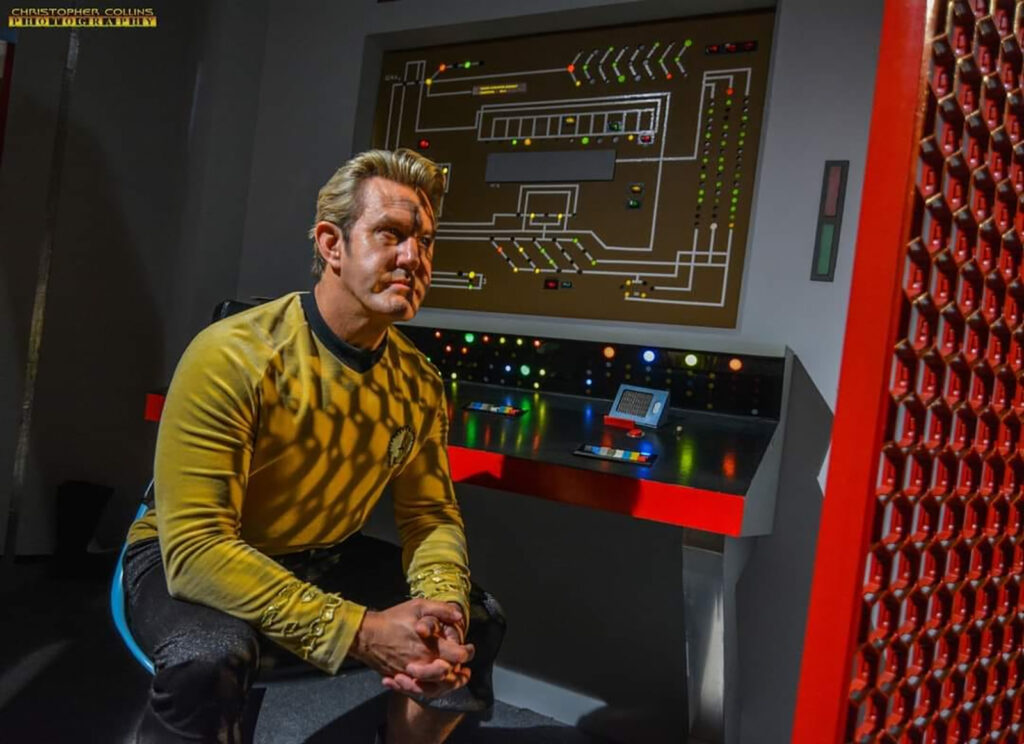
In part 1, we looked at the sixth release of TALES FROM THE NEUTRAL ZONE, a really excellent fanthology episode titled “THE LOST STARSHIP.” It was written by newcomer to Star Trek fan films, professional author BRIAN W. PETERSON. And our previous blog featured an awesome interview with Brian.
In this second and concluding blog, we shift to veteran fan filmmaker JOSHUA IRWIN (showrunner of the THE AVALON UNIVERSE series of fan films), who served as director of photography (DP) on the production under the supervision of director VIC MIGNOGNA (showrunner of the celebrated run of STAR TREK CONTINUES). If you haven’t seen “The Lost Starship” yet, please take the time to check it out, as it is amazingly well done…
As many long-time readers know, Josh graduated from film school a couple of decades ago and has worked professionally in the entertainment industry ever since. In fact, in January, his name will be in the credits as cinematographer of a new film being released in theaters across America titled Wildfire: The Legend of The Cherokee Ghost Horse (based on the famous song) starring country music singer CHEVEL SHEPHERD, the late ANNE HECHE, MO BRINGS PLENTY of Yellowstone fame, and the Highlander himself, ADRIAN PAUL. Josh was also cinematographer on three films that can be found on Tubi: Rain, Your Local News, and Uneven Ground: The Melissa Witt Story.
But of course, we’re here to talk about a Star Trek fan film, so let’s dive into our interview with Josh…
JONATHAN – Been a long time, hasn’t it?
JOSH – At least a month.
JONATHAN – At least! But hey, you’re a busy fan. Speaking of which, I know you’re working really hard on the next Avalon Universe release, CRISIS ON INFINITE EXCALIBURS. Before we get to “The Lost Starship,” is Crisis still slated to premiere in a few days on Halloween?
JOSH – Sadly, no. For the first time in five years, Avalon won’t have a release on October 31. We’ll be close, though. I expect sometime in mid-November. SAM COCKINGS is doing such an incredible job on the VFX, but he’s asked for a few extra weeks to get everything finished.
JONATHAN – I’ve seen some of the footage, folks, and I think this is going to be THE most talked-about Star Trek fan film of the year (no offense to any of the other 2023 releases). But this one is going to blow people away.
JOSH – Well, thanks, Jonathan…although people should be aware that you’re not exactly unbiased, since you helped write some of the script! LOL
JONATHAN – Not too much, though. And seriously, I’d be singing the praises of this fan film regardless. You and your team really have really exceeded all expectations with this one.
JOSH – I appreciate that, Jonathan.
JONATHAN – But before we forget why we’re here, let’s shift over to “The Lost Starship,” which is actually the third release from NEUTRAL ZONE STUDIOS that you’ve worked on in some capacity, the others being “DOOMSDAY” and “THE TEST OF TIME.” With Avalon Universe heading toward its fan series finale next year with THE ONCE AND FUTURE CAPTAIN, are you now transitioning to Tales from the Neutral Zone?
JOSH – For the time being, yes. I’ll be directing their next two episodes, at least, as one is already shot. After that, nothing is certain yet. But I definitely enjoy shooting there.
JONATHAN – Up until now, you’ve been a director of photography with Vic Mignogna directing. Will you be your own DP, as well, or will that be someone else?
JOSH – Well, for the film that’s already been shot, I framed and lit everything myself. So I was my own DP at least for the first one. Not sure yet about the second one.
JONATHAN – Well, even if you are transitioning (transitioning between fan series, that is!), I know that “The Lost Starship” was filmed back in February of this year. As I recall, you were still buried in production work for three different Avalon films at that point. How did they manage to talk you into driving twelve hours (each way!) from the northwest corner of Arkansas to southeast corner of Georgia for a four-day shoot for a totally different project?
JOSH – Actually, it’s a funny story. RAY TESI and Vic and Brian Peterson (the writer/producer) had made plans to shoot this in February. But the hiccup was that nobody had bothered to tell me. So I was talking to Vic on the phone at some point in January of this year, and he asked me, “Hey, are you gonna be joining us in February?” And I said, “Vic, I don’t know that the heck you’re talking about.” And he said, “Aren’t you doing this film?” And I said, “What film? I don’t know what you’re talking about.”
Vic explained that they were doing another Star Trek fan film, but nobody had talked to me about it. Now, I’ll be honest with you, Jonathan, I was more than a little concerned. I was about to do this big shoot for Avalon Universe where we were gonna be coming down there to shoot three films simultaneously. And I wasn’t sure I was going to have time for this because I was really concentrating on finishing up Avalon Universe, and I was afraid that this would get in the way.
JONATHAN – And did it?
JOSH – Frankly, yes. But as I explained to Vic that I just wasn’t sure I could fit this in, he said, “Josh, there’s no one else who could shoot this film and do it justice. And I don’t want to shoot this film unless you’re doing it. You’re the only one I trust to do it right.”
JONATHAN – And I guess that convinced you, huh?
JOSH – Yeah, when the guy who made the greatest Star Trek fan film series that’s ever been made says he wouldn’t shoot a film with anyone but you… I mean, yeah, that feels pretty good. So I was like, “Awww, okay.”
JONATHAN – So he pressed all the right buttons.
JOSH – Yeah, I guess he did. Vic can be very persuasive when he wants to be. But it wasn’t just Vic. Brian called me to follow up after I spoke to Vic. He said, “Hey, I’d love to have you on board. Do you have a little time to talk?” And I did. And before I’d even had a chance to read the script, he told me about his motivation for writing the script. He said, “I’ve always wanted to write a film where the entire crew dies at the end.” And I said, “You and I are gonna be friends.”
So I agreed to do it, we shot for four days, and my goodness, we had a great time! Throughout the process of shooting the movie, I got along really well with everyone but especially Brian. We had so much in common. I’d be making these obscure Star Trek jokes the entire time we were shooting, and he got them all.
JONATHAN – Do you remember any of them?
JOSH – Well, for example, Vic has a tendency to look through the lens and fiddle with the camera a little bit and show me what he wants. And the first time he ever did that, I told him, “I wouldn’t let anyone touch my camera but you.” And it’s true. When I’m DP, no one messes with my camera and lens settings. Period. But I let Vic do it because he knows what he’s doing. And Vic told me he sincerely appreciates that.
Anyway, at one point during the shoot, I had wandered off the set for a couple of minutes, and when I came back, Vic is all in my camera setting up the shot he wanted, making adjustments and stuff. And I said, “There’s a lot of that camera in me, Vic. When you touch it, it’s me.” And Vic didn’t immediately recognize that as a quote from Leah Brahms in the TNG episode “Booby Trap,” But Brian got it immediately, and he burst out laughing. And so Brian and I just had a really good time working together. I really like him. I think he’s a super, super nice guy. He’s an everyman, he’s a Star Trek fan. I loved his script, and I enjoyed talking with and meeting him and making a film with him. And now I’ve reached a point where, even if I can’t say no to Vic, I certainly can’t say no to Brian.
So despite the fact that I had a lot of other plans and priorities, I just decided, hey, let’s do this! And I don’t regret it one bit. I think we made a great film, and I’m really proud of it. I think, as much as INTERLUDE was tearing up the film festival circuit, I think this movie’s gonna be the same.
JONATHAN – So I take it the shoot itself went smoothly?
JOSH – Absolutely. It was a wonderful atmosphere. It was really relaxed. Everyone had a great time; everyone was treated very well, very respectfully. We came off of every shooting day feeling really good about what we did. We had great dinners together, great conversations together. It was the best kind of production environment you could have on any film.
Y’know, there’s a lot of things that go on behind-the-scenes and outside the studio that you don’t see. Like, we all went and did karaoke one night after shooting. Or we all went to Longhorn Steakhouse, or we went and did Hibatchi Grill. And then there’s this ritual that happens both at Fan Appreciation Weekend and on shoots—they have this pool at the nearby Best Western that everyone stays at, and we would just all go out to the pool, unwind, and hang out until two in the morning just talking and telling stories and having a good time.
JONATHAN – I never knew about any of that! Wow, that is so awesome. Now I really want to go and be part of a shoot there. See if you can write me into an upcoming Neutral Zone fan film…please.
JOSH – I’ll see what I can do. We’d love to see you down there, Jonathan.
JONATHAN – Yeah, it can be lonely all the way out here on the opposite coastline. But let’s get back to you, Josh. I know you were DP on this latest project. Did you do anything else, like edit the film?
JOSH – Not this time. I edited “Doomsday” and “The Test of Time.” But Vic edited “The Lost Starship.” I just did the airbrushing and the finish.
JONATHAN – What does that mean when it comes to a film?
JOSH – Okay, Vic cut together an edit, KEITH HAMILTON did CG, RALPH MILLER did sound design, and I just put it all together into the final presentation. I did some visual FX, too, like the transporter beams, some other minor stuff, and some chromakey composting.
JONATHAN But primarily, this time out, you were DP.
JOSH – Pretty much, yeah.
JONATHAN – Can you explain to folks what it is exactly that a DP does? I know you’ve said in past interviews that a DP “paints with light.” But I’d like to take this opportunity to dive a little deeper into the weeds to know what you do from the time you first walk onto the set until the direction says, “Action.”
JOSH – Okay, so the director of photography is responsible for the image that you see on screen—how the scene is lit, how the camera is set to shoot that scene. You might determine things like the exposure, lens choice, the depth of focus, the style of lighting, etc. So I’m in charge of the lighting and camerawork.
And the thing about lighting that most people don’t understand sometimes is that you’re lighting for shadow as much as you are for the lit areas. And I think that “The Lost Starship” is a really good example of that because the original Star Trek series had a lot of shadows in it. It had really dramatic lighting because it was actually inspired by stage lighting in a lot of ways. In fact, a lot of TV shows back then were inspired by theatrical presentations. And Vic is very, very meticulous about wanting to recreate the look of the original show, and that comes down to the lighting and camerawork. And one of the reasons they wanted so badly for me to do this is because I’ve gotten really good at being able to replicate the look of Star Trek over the years.
JONATHAN – So how many of the camera and lighting decisions came from you, and how many decisions came from Vic?
JOSH – Vic gave me a lot of freedom in how I approached these scenes from a photographic standpoint. Vic likes to concentrate on performances, and he tries to follow a formula of you shoot a wide shot where you cover a lot of the action in the scene, and then he goes in and gets some close-ups. So a lot like happened on “Test of Time,” he’s say, “Okay, we’re shooting on the bridge,” “We’re shooting in the briefing room,” “We’re shooting in sickbay,” and I would go to a TOS episode, and I would find a briefing room scene or a sickbay scene or whatever. And I would say, “Let’s light it like this sickbay scene from ‘Space Seed’ or this briefing room scene from ‘Tomorrow Is Yesterday” or something like that. And then we would light and shoot the scene to make it match the episode.
JONATHAN – Did you show him video clips from the original episodes or just screen caps?
JOSH – Screen caps were always enough for Vic to decide. And most of the time, he’d say, “Let’s do it that way.”
JONATHAN – So what separates a really good DP from just an average or not-so-good DP?
JOSH – A good DP is always thinking of motivation more than anything else. What is motivating the lighting for this scene? And there are two aspects of that. One can be practical motivation: what is the source of light in this scene? And the second thing is you’re trying to create a mood with the lighting. For example, there’s a briefing room scene in “The Lost Starship” where these officers discuss their issues with the captain, and it’s like five in the morning and everyone is real tired and they’re sneaking in there. So I kinda lit the briefing room a lot lower than you might normally see it. So there was an emotional scene motivation for how we lit it.
JONATHAN – I’m not sure if I’ve ever heard the word “motivation” used in reference to lighting a scene.
JOSH – It’s actually quite common in the industry. Motivation is your creative, I guess you could call it “reasoning” for a choice you make. Let’s say you’ve got a scene in the script that’s dark and moody. So you figure out a way to light the scene to reflect that. Maybe you use cooler colors, maybe you have lower lighting levels or it’s just darker. That’s the emotional motivation. Then there’s the practical motivation—what is lighting the scene? Is it lit by the sun? Is it lit by moonlight? Is it lit by incandescent light? And so you try to take those two inspirations and factor them in to how you create your set lighting.
So if you’re looking for a distinction between a good DP and a bad DP, a lot of people think that you turn the lights on and that’s it. “Is there enough light?” they’ll ask. Well, the amount of light really doesn’t matter. As a director of photography, you’re motivated by artistry. Where’s the shadow? Where’s the light? You’re almost thinking more about the lighting as DP then you are the camerawork. The camerawork almost becomes secondary. Okay, we’re doing a dolly shot here; we’re doing a close-up. But you’re gonna start a scene with how you light it, and then you’re gonna go from there.
And strangely enough, you’re also gonna start with the background and work your way forward to the talent. So you’re going to make sure that the background complements the talent or it draws attention to the talent or the background’s not too distracting. You really concentrate on the whole picture; it’s not a simplistic approach. You factor in all the different things that contribute to how you paint your canvas in that scene.
JONATHAN – Wow, that’s a lot to keep track of!
JOSH – Yeah, honestly, what you have to do is become obsessive. You have to become obsessed with filmmaking, and you have to become obsessed with what makes a good film to the point that you’re just becoming a junkie. You’re eating and sleeping and breathing it. You’re doing research, and you’re trying to find out what makes a good film and what makes good film lighting and what makes good cinematography.
One of my favorite things to do is learn about why someone made a choice that they did in a film. For example, I would read about how the movie Highlander got made, where that story came from, and why did someone want to tell that story? You have to get that obsessive with it. And then you start to learn about the people who have done it well. The greatest cinematographer of all time is a guy named ROGER DEAKINS, and he focuses really heavily on motivation. I’ve listened to a lot of interviews with him where he talks about how you have to make lighting believable. A lot of people will just stick two soft boxes behind a camera and call it good. And a great cinematographer will look at a scene and say, “How does the cinematography support the story?”
And in a Star Trek fan film, one of the biggest factors is that you’re trying to make it look like a Star Trek episode. And I think we did that quite successfully with “The Lost Starship.”

